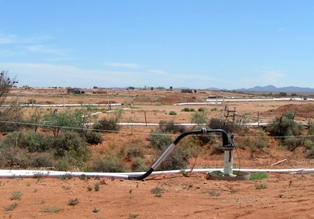Australia' Petratherm plans to start drilling to recover geothermal energy in South Australia in May 2009. The company has already signed a memorandum of understanding to provide power to Heathgate Resources' nearby Beverley uranium mine.
 |
| The Beverley ISL mine should be the first to produce uranium using renewable energy (Image: Heathgate) |
Geothermal energy works by pumping water thousands of metres underground into very hot bedrock, where it is heated and then pumped back up to the surface. This superheated water can then be used to produce steam to drive electricity generators. The two wells at Paralana - one for pumping water down, the other for retrieving it - are expected to be some 4 kilometres deep, where the bottom hole temperature is over 200oC. The high temperatures come not only from the depth of the rock but also from the radioactive decay of uranium in the strata, making atomic energy one source of the geologic heat.
Paralana is one of Australia's most advanced geothermal projects and is expected to produce the country's first commercial flows of geothermal energy in 2010.
Uranium to power renewables to power uranium
Petratherm said that the electricity demands of the Beverley mine are significant and are expected to grow substantially should nearby uranium deposits be exploited in the future. The company signed a memorandum of understanding (MoU) with Heathgate in November 2006 to explore potential opportunities in relation to supplying the mine with additional electricity over and above its current contracted requirements. Under the MoU, Petratherm, which is some 11 kilometres from the Beverley mine, will provide top-up power to the mine via an initial 7.5 MW plant with a potential to scale up to 30 MW.
At the time the MoU was signed, Heathgate's managing director Patrick Mutz told energyme.com, "This MoU is an excellent first step towards the future possibility that South Australia could host the first operating uranium mine powered by a renewable energy source."
Terry Kallis, Petratherm's managing director, commented, "There are potential mutual benefits to our company and Heathgate in progressing the supply of the mine's electricity needs from nearby geothermal-sourced outputs." He added, "Our objective is to supply Beverley with electricity at equal to, or lower in price than alternative sources including existing supply sources."
Kellis recently claimed that, "including estimated transmission and substation costs, Paralana will cost $190-200 million to develop initially to 7.5 MW capacity and then to the second stage 30 MW capacity." He added, "The third and fourth stages will take it to national grid status supplying base-load power of 260 MW and 520 MW."
Australia's third-largest energy retailer, TRUenergy, has agreed a $57 million farm-in entitlement to 30% of the Paralana project. Meanwhile, energy group Beach Petroleum has also made a $30 million farm-in commitment for 36% of the project.
The Beverley mine - Australia's first in-situ leach (ISL) mine - started operation late in 2000. It is licensed to produce 1180 tonnes U3O8 (1000 tU) annually, an output level it reached in 2004. It is owned and operated by Heathgate, an associate of General Atomics in the USA.




_18570.jpg)
_16159.jpg)
_18938.jpg)
_33584.jpg)





